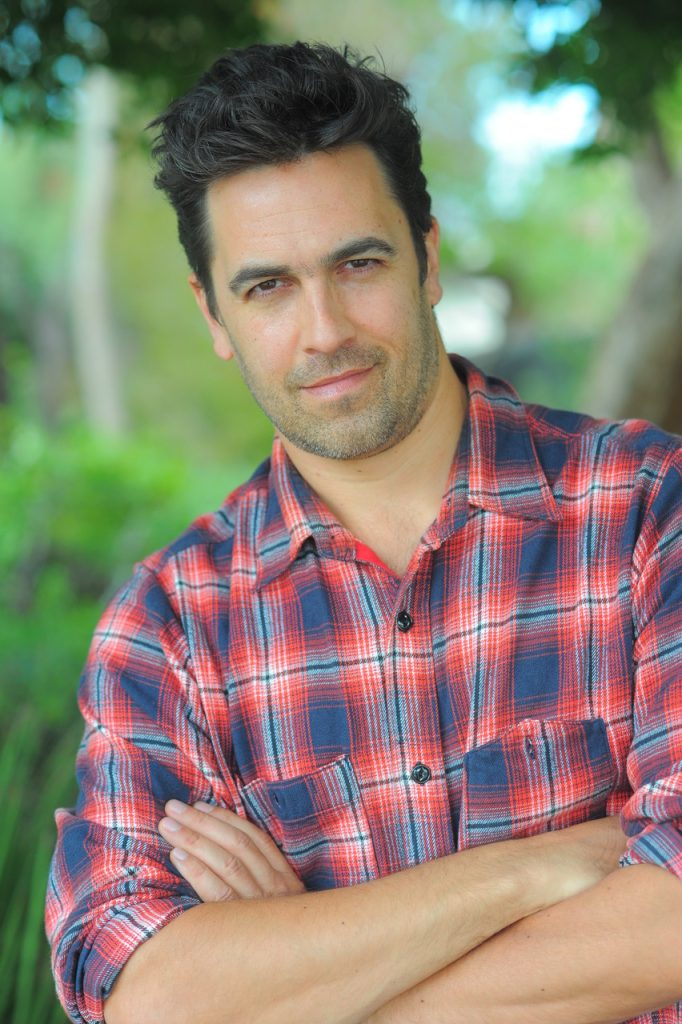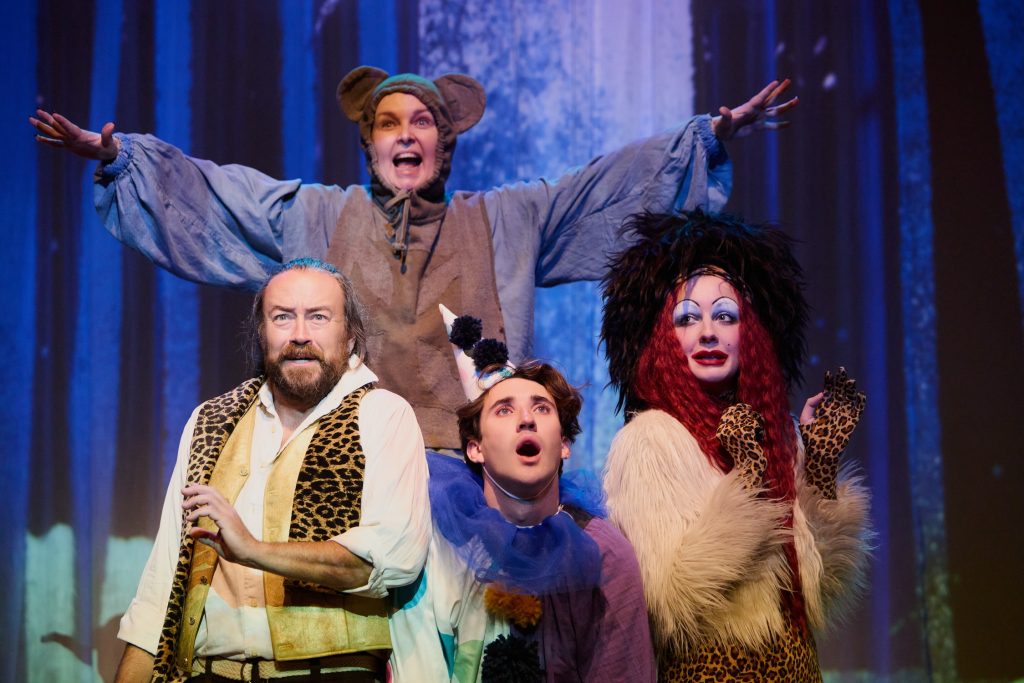There’s a certain magic that only The Actors’ Gang can conjure — one that balances whimsy with wisdom, imagination with heart. Running December 4th through the 20th, the acclaimed ensemble invites audiences to step into a new kind of winter wonder with Children of the Winter Kingdom — The Bonkers Adventures of Holly and Spruce, a world premiere written and directed by Adam Dugas in collaboration with co-playwright Mary Eileen O’Donnell. Far from the familiar carols and classics that populate the season, this original tale transforms the company’s Culver City home into Glassenvale, a snow-swept realm where courage, friendship, and theatrical wonder collide.

In true Actors’ Gang fashion, the story spins from chaos to compassion as orphan twins Holly and Spruce flee a menacing circus and find themselves in a kingdom teetering on the edge of enchantment and disorder. There, they encounter an ice spider, a dragon, and an assortment of peculiar souls, each brought to life through music, movement, and a touch of the surreal. Infused with the troupe’s signature commedia-inspired energy and Dugas’s taste for the unexpected, Children of the Winter Kingdom is primed to be an arctic adventure for the entire family.
At the heart of the production lies an idea as timeless as any fable: that home is not a place, but a discovery — a sentiment that mirrors Dugas’s belief in recognizing both the joy and quieter ache that the holidays can evoke. It’s a message that Artistic Director Tim Robbins says is central to The Actors’ Gang’s mission of uniting audiences through shared imagination and emotion. With its mix of humor, puppetry, and heartfelt storytelling, this new work offers a refreshing alternative to traditional holiday fare by celebrating the spirit and transformative power of theatre itself.
In speaking with LAexcites, Dugas reflected on the show’s roots in classic storytelling traditions to the emotional truths woven through Holly and Spruce’s journey. He discussed why curiosity stands in for fear, how early workshops were fruitful, and the ensemble-based creativity that turned Glassenvale from an idea into a living, breathing world.

What sparked the initial idea for Children of the Winter Kingdom, and how did your collaboration with Mary Eileen O’Donnell shape the story’s direction?
Dugas: Tim Robbins approached us in the spring as he was putting the season together for 2025-26, and he asked us to collaborate on a holiday show which typically has been a variety show, but we all agreed to make an original play as it seemed like a great opportunity to do something different.
In the past, I did a series of holiday shows in New York under the banner of Chaos & Candy, ranging from variety shows to a full rock ‘n’ roll musical about the monsters of Christmas folklore. I feel like I had done all that in the past, and my proposal to Mary Eileen was to capture the spirit of that holiday, and all the feelings — such as joy, sadness, but mostly joy — alongside a new story. We started with what the holiday season was like for us, and I was asking people in the company to get their real experiences [about the holidays], which varied, from happy stories to broken families and abusive homes, to people who never enjoyed it.
I feel it’s important to honor that without making it dark, and so like most fairy tales, it starts with orphaned children. We started with them being in a bad home. There’s one relative who loves them, and then we asked what happens next — and we went wild [laughs].

You’ve spoken about the classic tales that formed the bedrock of your storytelling. How did those foundational works inform the look, feel, or emotional core of this play?
Dugas: The holy text of my life is The Wizard of Oz — it’s such a magnificent work of art as a movie and as a unique American folktale. There’s also something to Dorothy or Alice (from Alice in Wonderland) being very no-nonsense, not being afraid of where they are, and being curious. I believe the opposite of fear is curiosity, and while these two kids (Holly and Spruce) are lost in this strange place, their curiosity and their innate good nature, or good spirit, take them to a better place.

And that better place is Glassenvale?
Dugas: Yes [laughs]. One of the first things we agreed on with Mary Eileen is not going back to black and white, but rather staying in color in the real world, doing what we can to make it feel right. That was one thing, and the other is that the children get sent off to the circus (before trying to escape from it). One of the other inspirations was David Copperfield, who was sent off to work in a bottle factory and met these amazing characters along the way.
[In Children of the Winter Kingdom], the children are escaping from the circus. It’s colorful and fun, without making it about Santa and Elves. It also [speaks to the] traditional Christmas celebrations as they were hundreds of years ago, which had a carnival-esque spirit, where everything goes upside down. There’s fun in hanging around animals, nature, and dressing up — and we felt all of this could be fun.

Children’s stories often operate on multiple levels — wonder for young audiences, emotional resonance for adults. How did you approach crafting a show that speaks to both without compromising the storytelling?
Dugas: I’ve been pointed to something like this for a long time and have loved classical works — and one thing I really liked was (Philip Pullman’s) His Dark Materials trilogy. There’s a reality to the emotions [in Children of the Winter Kingdom] which we’ve tried to stay true to as their first home is bad without being too ugly for the audience to watch. There’s a sadness, a loneliness, and alienation for many during Christmas, and it’s important to acknowledge that without making it too cruel. The original tradition [of Christmas] was closer to Halloween, as you’d knock on people’s doors, asking for food and drink, and having a party everywhere you went. You’d be essentially trick-or-treating but having parties and feasting. [With Children of the Winter Kingdom], it’s been chaotic and fun in capturing that and just being true to what people experience.
As the story unfolds, it’s mostly Holly who meets these characters and adapts to being lost and getting through her fear and finding friends and standing up for herself — it’s powerful to watch. The other characters, too, are having their own journey. The King is one of my favorite characters, as he’s lost his confidence as a king, but it’s meeting the kids that helps him. Seeing that and his arc of how to get over his issues is one of the more emotional things for me to watch; he’s the closest thing to me. It’s like watching my brain [laughs].

The production features music, puppetry, and visually driven storytelling. Which element proved the most creatively challenging, and which surprised you in the best way?
Dugas: We haven’t gotten all the puppets made yet, so that’s been the most challenging thus far [laughs]. We started rehearsal on the first [of November] and have had the set design rolling along with costumes and now puppets. That said, it must start with the actors in making the world feel real, whether it’s giant props or projections, like with matte painting backdrops from classic movies. The costumes will be great; Rynn Vogel does most of the costumes and she’s fantastic.
We have 12 actors playing up to three roles each, and it’s their versatility, elasticity, physicality, and voices that will make you believe in this world.

As this is a world premiere, what part of the process — be it early readings, workshops or rehearsals — most shaped the final form of the piece, and did anything evolve in a way you didn’t expect?
Dugas: That’s a good question. Overall, the workshop process of The Actors’ Gang is really special. I had five or six workshops to use the company to explore this world and see how the play worked. We got everyone dressed up as what they imagined these characters might be. I had proposals for what happened to the scenes, and that is where the King completely changed for me. I thought it would be an older actor, and it ended up being someone younger, and it was brilliant. The King is supposed to be on the throne since age 7, and even at 27, he’s a 20-year veteran of being a king [laughs]. That was the most surprising shift — the King not being an older man.
Once we explored the script in workshop, we got to see what worked, and what didn’t. The opening scene was supposed to be dialogue, but I wasn’t satisfied with it, and so I turned it into a song. It feels more alive and the show starts with a bang now.
It’s an exciting and active process to find it with company members who embody the style of The Actors’ Gang. Because it’s an ensemble company, we have the same language and are trained under the same style. We’re all able to snap into it — it’s powerful and amazing as an actor, director, and writer, and there’s much less explaining to do as everyone is on the same wavelength mentally and physically. When I say, ‘Let’s make an enchanted forest,’ it just starts to appear [laughs].

Lastly, for audiences coming in fresh to Culver City, what do you hope they carry with them when they leave Glassenvale and return to the real world?
Dugas: I just want them to carry this joy with them and feel like they got the sense of inspiration promised from this season [laughs] — feeling the spirit while being in a room laughing. The word ‘spirit,’ which means so many things, is a key part of this story and experience. There’s one’s personal spirit, the spirit of humankind, the holy spirit, etc. It ultimately means energy, and it’s been one of the guiding words, and I hope people get the spirit of being at the show.
Cover image caption: Madison Davis as Holly and Jacob Dodson as Spruce in The Actors’ Gang production of Children of the Winter Kingdom in Culver City, CA. Photo by Bob Turton Photography.
The Actors’ Gang production of Children of the Winter Kingdom runs from Thursday, December 4th through Saturday, December 20th. For information and tickets, visit ci.ovationtix.com.

